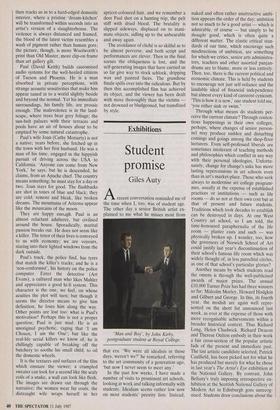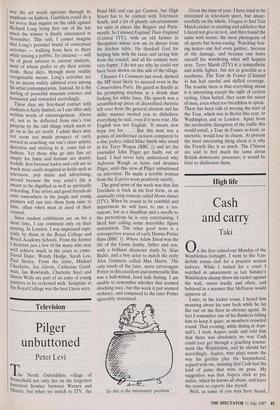Exhibitions
Student promise
Giles Auty
Arecent conversation reminded me of the time when I, too, was of student age. The other day a senior British artist ex- plained to me what he misses most from 'Man and Boy', by John Kirby, postgraduate student at Royal College.
that era. 'We were all idealists in those days, weren't we?' he remarked, referring to the art community of a generation ago, 'but now I never seem to meet any.'
In the past few weeks. I have made a number of visits to prominent art schools, looking at work and talking informally with students. Idealism seems rather low now on most students' priority lists. Instead, naked and often rather unattractive ambi- tion appears the order of the day; ambition
not so much to be a good artist — which is admirable, of course — but simply to be thought good, which is often quite a
different matter. The elastic critical stan- dards of our time, which encourage such misdirections of ambition, are something for which we critics, senior arts administra- tors, teachers and other assorted panjan- drums are to blame, more or less entirely. Then, too, there is the current political and economic climate. This is held by students to encourage not just self-reliance and the laudable ideal of financial independence but almost every kind of careerist cynicism. 'This is how it is now,' one student told me, 'you either sink or swim.'
Through what means do students per- ceive the current climate? Through conten- tious happenings in their own colleges, perhaps, where changes of senior person- nel may produce sudden and disturbing comings and goings among the shop-floor lecturers. Even self-professed liberals are sometimes intolerant of teaching methods and philosophies which conflict in any way with their personal ideologies. Unfortu- nately, change for change's sake has more lasting repercussions in art schools even than in art's market-place. Those who seek always to modernise art college program- mes, usually at the expense of established practices or institutions — such as life rooms — do so not at their own cost but at that of present and future students. Traditions which took decades to establish can be destroyed in days. At one West Country art school, so I am told, the time-honoured paraphernalia of the life room — plaster casts and such — was physically broken up. I wonder, too, how the governors of Norwich School of Art could justify last year's discontinuation of their school's famous life room which was widely thought of, in less parochial circles, as one of that school's particular glories?
Another means by which students read the omens is through the well-publicised awards of major prizes. The annual £10,000 Turner Prize has had three winners so far: Malcolm Morley, Howard Hodgkin and Gilbert and George. In this, its fourth year, the modish are again well repre- sented on the short list announced last week, as ever at the expense of those with more recognisable achievements within a broader historical context. Thus Richard Long, Helen Chadwick. Richard Deacon and Therese OuIton embody in their work a fair cross-section of the popular artistic fads of the present and immediate past. The last artistic candidate selected, Patrick Caulfield, has been picked not for what he has produced but merely for what he chose in last year's The Artist's Eye exhibition at the National Gallery. By contrast, John Bellany's truly imposing retrospective ex- hibition at the Scottish National Gallery of Modern Art in Edinburgh goes unrecog- nised. Students draw conclusions about the
way the art world operates through its emphasis on fashion. Gamblers could do a lot worse than inquire on the odds against Richard Long being first out of the hat When the winner is finally announced in November. This said, I cannot imagine that Long's personal brand of conceptual activities — walking from here to there While tossing a pebble, for instance — will be of great interest to current students, most of whom prefer to ply their artistic trade, these days, through more readily recognisable means. Long's activities are by no means widely admired even among his artist contemporaries. Instead, he is the darling of powerful museum coteries and honoured and rewarded accordingly.
These days my first-hand contact with students is fairly limited, so I can offer only written words of encouragement. Above all, not to be deflected from one's true Purpose by the odd things which seem to go on in the art world. I admit there may not seem too much prospect of early reward in searching out one's inner artistic direction and sticking to it, come fad or fashion. Yet those who go into fine art
y for fame and fortune are doubly foolish: first because kudos and cash are so much more easily acquired in fields such as television, pop music and advertising; second because the true artist's life is meant to be dignified as well as spiritually rewarding. Fine artists and good friends do exist somewhere in the jungle and young painters will run into them from time to time, often when most in need of their counsel.
Since student exhibitions are on for a short time, I can comment only on their Passing. In London, I was impressed espe- cially by those at the Royal College and Royal Academy Schools. From the former I mention just a few of the many who may well achieve much in the years to come: David Duke, Wendy Hodge, Sarah Lee, Paul Storey. From the latter, Michael Checketts, Joy Girvin, Catherine Good- man, Ian Rowlands, Charlotte Steel and Simon Wells are part of an army of young painters to be reckoned with. Sculpture at the Royal College was the best I have seen.



















































 Previous page
Previous page